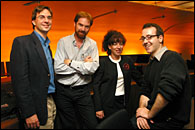Renaissance in the Arts
 New Faculty of Arts professors, left to right: Michel Biron, French; Lyudmila (Lucy) Parts, Russian and Slavic Studies; James Delburgo, History; Kevin Kee, History.
New Faculty of Arts professors, left to right: Michel Biron, French; Lyudmila (Lucy) Parts, Russian and Slavic Studies; James Delburgo, History; Kevin Kee, History.PHOTO: Owen Egan |
|
Welcome to McGill, Lyudmila Parts. As one of 24 new professors hired by the Faculty of Arts this year, the youthful Columbia University PhD graduate is a freshly minted Russian Studies instructor who personifies a dynamic turn for the Faculty: Renewal.
Carman Miller, dean of arts, says the arrival of Parts and her peers has given the Faculty of Arts 24 reasons to rejoice. "We are in the midst of a Faculty renaissance," trumpeted Miller, during a Sept. 17 Faculty of Arts meeting and celebratory cocktail.
Parts is delighted to be part of that revival, she says, since McGill students provided the inspiration to come onboard. During a sample class she gave at McGill as part of her selection process, she recalls, "I found McGill students were at a much higher academic level than at Columbia.
"I was quite impressed."
Now, says Miller, it will be up to arriving professors to continue enhancing the University's tradition of excellence. "McGill has no reason to exist unless it offers top quality education," he says.
Boosting the quality of education will continue to be a priority next year, too. The Faculty of Arts plans to hire 50 tenure-track professors by 2004. These academics will be part of 130 new professors McGill will employ over the next year, as part of the University's commitment to hire 100 new professors every year until 2012.
For the Faculty of Arts, 50 new hires will enable the capping of some classes to 20 students per professor, versus the current average that ranges from 27 to 35 students. McGill has budgeted an extra $4 million per year in salaries for the effort.
"That sends an important message that teaching is important at McGill," says Miller. "It reinforces that the Faculty of Arts is McGill's core; the bridge to all other faculties."
Provost and Vice-Principal (Academic) Luc Vinet agrees. "The Faculty of Arts is at the heart of McGill. Our aim is to redress an inadequate situation, where too many students share professors," he says. "We had a choice -- we could either reduce the number of students or hire more professors.
"We chose to hire more teaching staff."
 |
||||
|
McGill wants to enhance interdisciplinary research and we're encouraging each department to search for talent beyond their faculty borders. |
||||
Hiring new professors, Vinet says, will help the Faculty of Arts realign its importance within McGill and provide an opportunity to hire experts in vanguard subjects or add instructors in popular fields. He's also met every department director from the Faculty of Arts to encourage the collaboration with other faculties in recruiting.
"There's an increasing number of areas, from management to the arts, where professors can collaborate," Vinet says. "McGill wants to enhance interdisciplinary research and we're encouraging each department to search for talent beyond their faculty borders."
Two professors slated for imminent recruiting will converge between the faculties of arts and medicine. The Department of Economics, for instance, will hire a professor specializing in health economics, while the Department of Sociology plans to take on a professor with expertise in health and illness.
The Faculty of Arts is working towards a research renaissance, too. Research officer Jo Ann Lévesque has been hired to help professors obtain more study grants. "We are McGill's first faculty to have a research officer," Miller says. "This is an experiment that all the other faculties are watching."
Although the Faculty obtained about $2 million in research funding last year, making it one of Canada's top arts research universities, Miller wants that figure to increase. "We do well, but we can do better," he says, adding Lévesque will provide graduate students with research support as well.
By far the biggest physical renewal awaiting the Faculty of Arts, however, is the construction of new quarters. Miller says the University is committed towards the construction of Phase I of a 4,500 square foot arts building on Peel St., the site of the former Powell Student Services Bldg, which will house professors and support staff presently located at 688 Sherbrooke St. "We hope to break ground on this new building by fall of 2003."
A second phase, which will cost up to $25 million, will include classrooms and research or public spaces. The Faculty is scouting for benefactors. "McGill fully supports the construction of new arts buildings," says Vinet. "We're determined to meet this challenge."
Carman Miller is heartened by the University's support towards his Faculty. "With the revitalization of our faculty, the addition of new space and the increase of our research," he says. "McGill is sure to become the leading Faculty of Arts in Canada."
The following is a breakdown of the number of professors that each Faculty of Arts department plans to hire by 2004: Anthropology (1) Arts History and Communication Studies (3), East Asian Studies (1), Economics (8), English (8), Hispanic Studies (1), History (6), Islamic Studies (2), Italian Studies (1), Philosophy (3), Political Science (7), Social Work (1) and Sociology (6).

